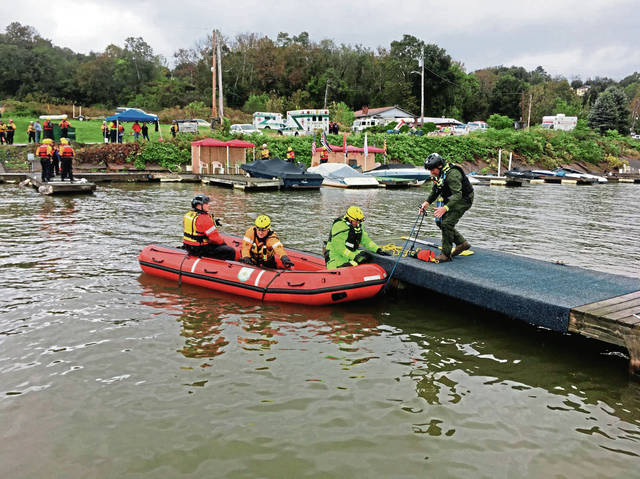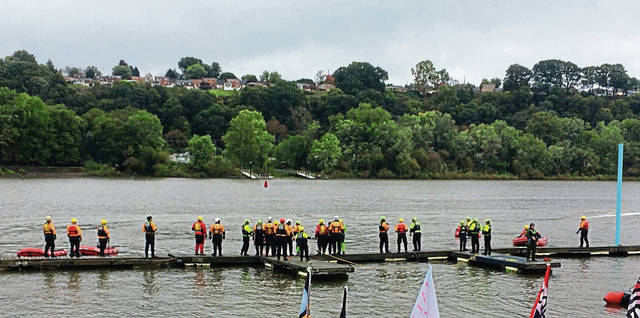Water rescue teams from 6 counties train on Allegheny River in O'Hara
The greater frequency of storms is just another reason for regional swift water rescue personnel to hone their skills on the Allegheny River on Saturday in O’Hara.
“Hurricane Ready” was the rescue focus for about 120 certified water rescuers from six counties. They’re part of the Pennsylvania Region 13 Homeland Security’s swift water rescue team.
The Region 13 team is mostly made up of volunteers from a number of community fire and rescue departments throughout southwestern Pennsylvania and the City of Pittsburgh’s water rescue employees. The team responds to water rescues locally, throughout the state or even different parts of the country when requested.
In the past two years, the region has been soaked by record-breaking rains, and the team continuously prepares.
Last year was the wettest year since records have been kept since 1871 with nearly 58 inches of precipitation (rain and snow). That’s significantly higher than the normal average precipitation of about 38 inches, according to Lee Hendricks, a meteorologist with the National Weather Service in Moon Township.
And the region is on track for 2019 to make the top 10 wettest years with 42 inches of precipitation as of Saturday, easily besting the average normal at this time of about 31 inches, Hendricks added.
“Because of the greater frequency of flash floods, these guys got to be at the top of their game,” said Scott Grahn, an instructor and trainer of swift water rescue for 30 years for the Pennsylvania Fish and Boat Commission.
Drills at Bell Harbor marina Saturday included rescuing a fictitious busload of people thrown into the water, the “victims” portrayed by other rescue workers who jumped into the Allegheny .
“You’re not here to hold hands,” Grahn bellowed, urging the victims to scatter throughout the water to wait for the emergency responders to snatch them up in the rescue boats.
Clad in waterproof clothing and gear, rescuers zipped around in the standard inflatable boats pulling out the victims.
They also practiced their boat-to-boat transfers of victims, righting capsized boats, helping disabled vessels and navigating a slalom course to sharpen their control of their own boats.
On site was the “Creature Craft,” Blawnox Volunteer Fire Company’s special inflatable boat with a roll cage design allowing it to stay afloat up against fixed crest dams and in rough water.
“It’s standardized training across the state, and a drill like this helps everyone practice working together,” said George McBriar, chief of Blawnox Volunteer Fire Company and member of the Pennsylvania Region 13 Maritime Committee. “A regionwide event like this, which we hold two to three times a year, allows us to train with a Washington County or a Butler County team.
Blawnox, which responds to communities near it and periodically beyond, averages about 26 water rescue calls a year, according to McBriar.
Chances are that when a call comes in many of the volunteer swift water rescuers won’t be able to leave work or help, so the rescue teams are often made up of a few people from a scattering of companies.
Keeping volunteers interested and together is the goal, especially when the number of calls fluctuates, according to Dan Felack of New Kensington, who is marine commander of Lower Kiski Swift Water Rescue/Flood Response/Public Safety Dive Teams. His outfit responds to about 10 calls a year. For example, last year Felack said the Lower Kiski team had eight dives but none so far this year.
Water rescue training is highly specialized and not called upon regularly as responding to fires and traffic accidents.
“Water rescues occur at a lower volume but are highly difficult,” said Matt Kauper of O’Hara, swift water rescue instructor with the Fish and Boat Commission and a lieutenant with the Blawnox Volunteer Fire Company.
One of the sobering parts of a mass rescue is sometimes “you can’t get everyone in a water rescue,” Grahn said. “People who are driving cars in these storms,” he said, “they need to turn their vehicles around to get away from rising water.”
Remove the ads from your TribLIVE reading experience but still support the journalists who create the content with TribLIVE Ad-Free.



